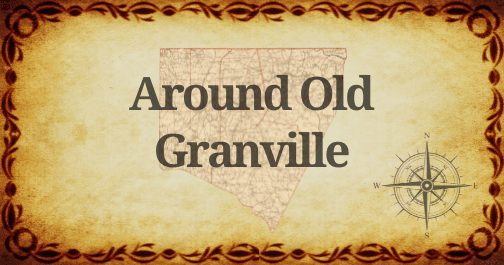Religious scholars and historians have labeled the general time frame between 1760 and 1800 as The Great Awakening, a time of religious revival that basically helped to shape – and reshape – how Christians viewed their relationship with their churches in the era before and after the American Revolution.
Granville County was established in 1746, and by the time the Great Awakening was taking hold in the American Colonies, three main denominations were prevalent here, said Mark Pace, local historian and North Carolina Room specialist at the Richard Thornton Library in Oxford.
They were Baptist, Presbyterian and Anglican – which morphed into the Episcopal Church after the Revolution, Pace said on the tri-weekly Around Old Granville segment of TownTalk.
But Methodism came on the scene in 1784, and with it, a few wrinkles.
“Methodists are interesting,” Pace said, “and it can be a little complicated.”
By the 1870’s, there were Methodist Protestants and Methodist Episcopal churches, he said. One of Henderson’s Methodist Protestant churches was located where the city’s iconic clock tower now stands; another, near McGregor Hall and the police station.
That branch of Methodism became part of the United Methodist Church when it was formed in 1939. The Methodist Protestants preferred to have individual control, much like the Baptists; they didn’t want bishops and dioceses to make decisions for them.
As for the Methodist Episcopal churches, there was a further split between the Northern and Southern churches in 1844 because of slavery, Pace said.
There was even a church of “O’Kelly-ites” in Dexter, he said, that existed until the 1870’s. James O’Kelly was an itinerant Methodist preacher who left the denomination and was an outspoken opponent of slavery as early as the 1780’s.
The Presbyterian Church took root in Old Granville in the 1760’s, again predating the American Revolution. The Mother Church is Grassy Creek Presbyterian, where the Rev. Mr. Stradley preached from 1840 until 1910 or so.
Stradley is but one example of a local pastor “that’s the heart and soul” of a community. Others include Rev. Reginald Marsh and John Chavis. Chavis, a free Black man who fought in the American Revolution and graduated from Princeton, often preached in Presbyterian churches throughout the area.
For more than 60 years – 1850 to the 1910’s – Marsh was a Baptist minister who was instrumental in the formation of Island Creek and First Baptist in Henderson, among others, Pace said.
In those days, church pews were more likely to be filled with black and white people – granted, they often sat in separate sections – but Pace said after Emancipation, there was a movement for freed Blacks to form their own churches and establish their own communities.
Shiloh Baptist Church in Henderson and Big Zion AME Zion Church between Henderson and Oxford are two of the oldest churches that fit that bill.
Many Blacks stayed with the Baptist Church and with the Presbyterian Church after the Civil War ended, but Pace said the Presbyterian Church was probably the denomination most devoted to abolitionism.
And there are a multitude of examples that still exist in the area today – Timothy Darling Presbyterian in Oxford, founded by George Clayton Shaw, and Cotton Memorial in Henderson, founded by Adam Cotton.
Walter Pattillo, a Baptist preacher, founded a lot of churches. He was born into slavery, Pace said, but it is believed he already knew how to read and write before he went to Shaw University to study theology.
Another one of those figures that gets involved in the community, Pace said: “they don’t go anywhere – they just stay here.”
No moss gathered under Pattillo, however. He is associated with establishing a long list of churches throughout the Old Granville area, including Michael’s Creek, Blue Wing near the Virginia line, New Jonathan Creek, Olive Grove, First Baptist in Oxford, Penn Avenue, Flat Creek and Cedar Grove.
Back in those early days, when most people farmed and were, for the most part, self-sufficient, Pace said the church provided the “social fabric” of a community. The church, or meeting house, or wherever the congregations met, were so much more than a place to attend a weekly service.
“People were heavily involved in the church,” Pace said, “and the church was heavily involved in your life.”
Church members could be summoned and tried before a church council for such sinful things as cursing, drinking, gambling, adultery, consistent absence from the church, or – Pace’s personal favorite – “general meanness.”
CLICK PLAY!
